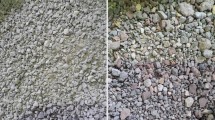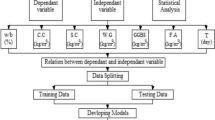Abstract
In this study saw wastes of wood, rattan and bamboo were used in mortar as a partial replacement of fine aggregate at different proportion. The variation of strength with time, density and water absorption, modulus of elasticity, and poisons ratio were identified. The test result was verified with the standard of mortar strength. Comparing to sand, being lighter in weight the above mentioned saw wastes decreased the weight of mortar. It can be considered as a new possibility of producing lightweight mortar as a building material. The test values were checked/verified using Artificial Neural Network (ANN). Also multivariable equations were generated to predict the strength of mortar. Finally it was seen that prediction using ANN has closer position with the test result instead of the equations.
Similar content being viewed by others
References
Algin, H. M. and Turgut, P. I. (2008). “Cotton and limestone powder wastes as brick material.” Construction and Building Materials, Vol. 22, Issue 6, pp. 1074–1080.
Babayemi, J. O. and Dauda, K. T. (2009). “Evaluation of solid waste generation, categories and disposal options in developing countries: A case study of Nigeria.” J. Appl. Sci. Environ. Manage, Vol. 13, No. 3, pp. 83–88, DOI: 10.4314/jasem.v13i3.55370.
Corinaldesi, V. (2012). “Study of lightweight mortars made of wooden waste.” Advanced Materials Research, Vol. 548, pp. 34–41, Trans Tech Publications, Switzerland, DOI: 10.4028/www.scientific.net/AMR.548.34.
David, R. L. and McCabe, G. J. Jr. (1999). “Evaluating the use of goodness-of-fit measures in hydrologic and hydroclimatic model validation.” Water Resources Research, Vol. 35, No. 1, pp. 233–241.
Elattar S. M. S. (2009). “Towards a global vision for building technology future.” European Journal of Scientific Research, Vol. 30, No. 3, pp. 495–504.
Garrick, M., Cunnane, C., and Nash, J. E. (1978). “A criterion of efficiency for rainfall-runoff models.” J. Hydrol., Vol. 36, Issues 3-4, pp. 375–381.
Halima, C. and Bachir, C. (2013). “Valorization of wood sawdust in making porous clay brick, Scientific Research andnd Essays.” Academic Journals, Vol. 8, No. 15, pp. 609–614, DOI: 10.5897/SRE12.608.
Haque Mohaiminul, Sourav Ray, and Mahzuz, H. M. A. (2012). “Use of stone powder with sand in concrete and mortar: A waste utilization approach.” authorized by: ARPN Journal of Science and Technology, Vol. 2, No. 7, pp. 613–618.
Kameswari, K. S. B., Bhole, A. G., and Paramasivam, R. (2001). “Evaluation of Solidification (S/S) process for the disposal of arsenic bearing sludge in landfill sites.” Environ. Eng. Sci., Vol. 18, Issue 3, pp. 167–176.
Lin, D. F. and Weng, C. H. (2001). “Use of sewage sludge ash as brick material.” J. Environ. Engin., Vol. 127, No. 10, pp. 922–927 (6 pages), DOI: 10.1061/(ASCE)0733-9372.
Mahzuz, H. M. A., Ahmed, A. A. M., and Yusuf, M. A. (2011). “Use of stone powder in concrete and mortar as an alternative of sand.” African Journal of Environmental Science and Technology, Vol. 5, No. 5, pp. 381–388, DOI: 10.5897/AJEST10.108.
Mahzuz, H. M. A., Alam, R., Alam, M. N., Basak, R., and Islam, M. S. (2009). “Use of arsenic contaminated sludge in making ornamental bricks.” Int. J. Environ. Sci. Technol., Spring, Vol. 6, No. 2, pp. 291–298.
Nash, J. E. and Sutcliffe, J. V. (1970). “River flow forecasting through conceptual models, I, A discussion of principles.” J. Hydrol., Vol. 10, Issue 3, pp. 282–290.
Rouf, M. A. and Hossain, M. D. (2003). Effect of using arsenic-iron sludge in brick making, The international symposium on fate of arsenic in the environment organized by Bangladesh, University of Engineering and Technology (BUET), Dhaka, Bangladesh and The United Nations University, Tokyo, Japan with assistance from ITN Centre, Bangladesh. (found in http://webcache.googleusercontent.com/search?q=cache:GNnnfPtdWh4J:archive.unu.edu/env/Arsenic/Dhaka2003/15-Rouf.pdf+&cd=1&hl=bn&ct=clnk&gl=bd, accessed at 18/12/2014).
Sanchez, F., Garrabrants, A. C., Vandecasteele, C., Moszkowicz, P., and Kosson, D. S. (2002). “Environmental assessment of waste matrices contaminated with arsenic.” J. Hazard. Mater., Vol. 96, Issues 2-3, pp. 229–257, DOI: 10.1016/S0304-3894(02)00215-7.
Willmott, C. J. (1981). On the validation of models, Phys. Geogr., 2, pp. 184-194.
Author information
Authors and Affiliations
Corresponding author
Rights and permissions
About this article
Cite this article
Mahzuz, H.M.A., Ahmed, M., Hossain, M.M. et al. Evaluation of strength of mortar using different saw waste with sand and model development. KSCE J Civ Eng 20, 2822–2831 (2016). https://doi.org/10.1007/s12205-016-0054-z
Received:
Revised:
Accepted:
Published:
Issue Date:
DOI: https://doi.org/10.1007/s12205-016-0054-z




